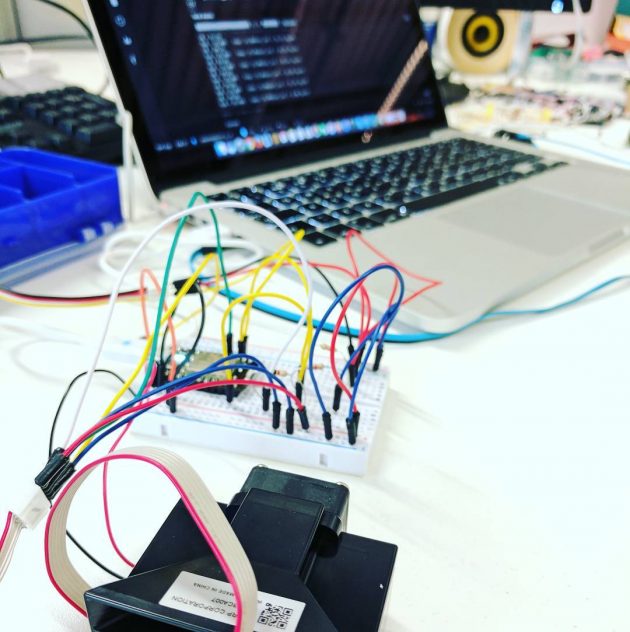Media Innovation Studio: international research, creative methods and multidisciplinary approaches
Spanning disruptive technologies, data journalism, 3D manufacturing, community engagement and storytelling, the Media Innovation Studio has a broad remit to explore innovation from many perspectives.
Based at the University of Central Lancashire in the UK, the Media Innovation Studio was formed in 2012 by a core team of journalism and media academics with a remit to explore, research and create prototype technologies and their impact on communities and society.
Based around an action research model – one that creates products, prototypes and processes in addition to studying their effectiveness, the Studio also feeds into the student experience. Acting as a ‘learning lab’, it seeks to create innovative teaching experiences for journalism and media students from across the university’s Faculty of Culture and the Creative Industries.
The Studio has four key values: to innovate media, conduct world class research, foster interdisciplinary working through creative collaboration and to enrich community, in whatever form they may take.
John Mills, a research and lecturer based at the Studio and one of the founding members, explains:
“The Studio was founded to create an interdisciplinary lab that would research and create new technologies and systems. As a research lab, we’re also interested in how technology can disrupt as well as reinforce, so much of our work is challenging to industry and sector norms, or presenting existing technologies in new and innovative ways.”
Methods
With a range of disciplines based out of the Studio, it deploys a range of methods to gain and gather insights, generate data, prototype and test. These span creative facilitation, Hacks, deploying cultural probes, which seek to generate rich insights rather than mass data, and rapid prototyping. The team also seeks to collaborate with partners, and industry and community connections to ensure the projects they run have rich research base and relevance to audiences, communities and users.
“Through combining a range of methodological approaches, we hope to create unique and novel insights to prototype development and research pathways,” Mills explains.
The team also leans on standard social sciences methods, such as carrying out semi structured interviews, surveys and traditional market and academic reviews and market reports. What forms the centre the work, is to prototype, test and iterative, which leans on more agile development approaches.
Projects
The Media Innovation Studio has been involved in a wide variety of projects since it formed. These include the Civic Drone Centre, which sought to understand how UAVs could “be used for good” across search and rescue, humanitarian aid and media uses, and DataMakers .
More recently, the team have been exploring the Internet of Things, proximity broadcasting and hyperlocal data. Examples include:
- NewsThings: Funded by Google’s Digital News Initiative, NewsThings is exploring what news and information-themed Internet of Things could be through working closely with audience, newsrooms and a multidisciplinary team. Project partners include Trinity Mirror Regionals and creative agency Thomas Buchanan. For more info on the NewsThings project, head over to our dedicated project profile page.
- CAST: CAST is a research project that is currently running in Armenia. We are introducing a local WiFi/intranet-style network to three remote villages. The project is looking into whether information can be provided in remote locations with little to no connectivity, or where connectivity is expensive or unreliable, as well as places where media may be controlled. It will test new digital ways for villages to connect with news, information and each other, without being connected to the internet. We will be using WiCastr devices. It uses freely available WiFi to make content available that you can access on your phone or laptop. Our hope is to support local communities in Armenia to develop and thrive. The aim is to test CAST as a digital ‘word of mouth’ tool and to see how this new technology can be used to make news and information available, especially in areas which have limited access to such resources. The research aims to prompt and demonstrate the social and commercial potential of CAST as a new local media ecosystem.
- Media Mill: While the field of open data is not new, it is becoming apparent how little it is utilised at a hyperlocal level: only 4% of 18,000 data sets in direct.gov.uk come from the 326 local councils. The Media Mill project aims to drive the development of open source, open data platforms in Leeds and York; enable collaboration between all partners to identify ways that local data can be transformed into media experiences (with an emphasis on mobile) that have value for citizens; and support research into the various business propositions that surround the project with a view to sustaining a thriving hyperlocal media ecology for the city-region.
- HOMING: An interactive sound art work, Homing explores how media can be conveyed in a small geographic area. Created by artists Jen Southern and Sam Thulin alongside the Media Innovation Studio, the installation, based in Preston’s central square, takes the original letters of soldiers in WW1, and presents them in digital form to users as they approach the cenotaph. Depending on location, a sound composition from the cemeteries at the Somme can be heard, with all the sensory qualities of the local conditions; wind, rain, whistling, stonework. Out on the Flag Market, these sounds give way to fragments of stories from the men in the trenches. Homing uses sound to make connections at a distance; between presence and absence, people and place, displacement and home.
The future
Working in innovation, Mills suggests it’s difficult to predict specifically what the next 12 months will bring. However, he is certain that industry, academic and community partnerships will form a substantial part of it. Previous projects have involved SMEs, regional publishing groups such as Trinity Mirror and Johnston Press, national publishers such as Haymarket Media, hyperlocal media and independent production companies. In addition to these industry partnerships, the centre’s research has also involved a breadth of community groups and institutions.
“The last five years has been both challenging and exciting, and our partnerships – which range from local schools and museums to international publishing houses – are key to our activities. We’ll continue to develop concepts, ideas and research via disruptive and emergent technology. We hope to make a positive contribution to both journalism and the media more generally,” Mills explains.
He expects that future projects will span IoT, augmented print, proximity broadcasting and areas that are yet to be imagined.
CONTACT POINT:

John Mills, Lecturer and Researcher, Media Innovation Studio
Web: http://mediainnovationstudio.org/
Twitter: @_johnmills

